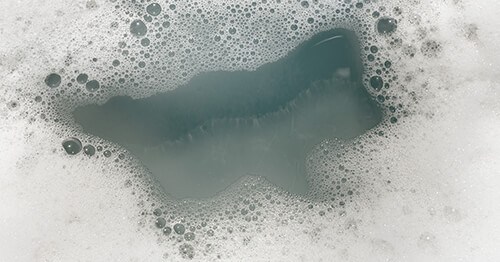They are making several good pointers relating to Why sewage is coming up through your bathtub as a whole in this content just below.

Sewer backup in the tub can be an upsetting and unsanitary trouble for any kind of homeowner. Not just is it troublesome, yet it likewise positions severe health and wellness risks and suggests underlying concerns with the plumbing system. Recognizing why sewer is coming up through the tub is vital for taking appropriate activity to address the issue properly.
Intro to the Issue
Typical Reasons for Sewage Back-up
Obstructions in the Sewage System Line
Among one of the most usual root causes of sewer back-up is an obstruction in the drain line. This can occur due to the build-up of particles, oil, or international objects in the pipelines, stopping appropriate circulation and triggering sewage to support right into your bath tub.
Tree Root Invasion
Tree origins seeking wetness and nutrients can penetrate sewage system lines via tiny fractures or joints. With time, these origins can expand and broaden, creating significant damage to the pipelines and leading to sewage backup problems.
Understanding the Trouble
When sewer draws back up right into the bath tub, it's a clear indication of an issue with the drain system. The wastewater that must be moving away from your home is instead discovering its back right into your space, which can lead to considerable damage and health hazards.
Possible Reasons
Numerous variables can add to sewer backup in the tub. From obstructions in the sewer line to concerns with the plumbing infrastructure, determining the root cause is important for discovering an option.
Aging Facilities
Older homes may have outdated plumbing systems that are more at risk to rust, fractures, and wear and tear. As pipelines age, they end up being a lot more vulnerable to leakages and clogs, raising the probability of sewage back-up incidents.
Heavy Rainfall or Flooding
During periods of heavy rainfall or flooding, the sewer system might come to be overloaded with excess water, triggering back-ups and overflows. This can lead to sewage backing up into tubs and various other fixtures inside the home.
Indicators of Sewer Back-up
Foul Odors
Undesirable smells originating from drains or fixtures, especially in the restroom, might suggest sewage back-up problems. These odors are typically strong and persistent, signifying an issue that needs immediate focus.
Slow Draining Fixtures
Bathtubs, sinks, and bathrooms that drain gradually or otherwise in all could be experiencing sewer backup. If numerous fixtures are impacted at the same time, it's most likely that the issue originates from a common point, such as the primary sewer line.
Gurgling Sounds
Strange gurgling or gurgling noises originating from drains when water is running elsewhere in your home are indicative of air entraped in the plumbing system. This air build-up can arise from sewage backup and need to be checked out promptly.
Wellness Risks Related To Sewer Backup
Contamination of Water
Sewage back-up can infect the water system in your house, presenting a significant health risk to you and your family. Direct exposure to infected water can result in gastrointestinal concerns, skin infections, and various other illnesses.
Mold Growth
Moisture from sewage backup can create optimal conditions for mold growth in your home. Mold and mildew spores can aggravate respiratory system troubles and cause allergies in sensitive individuals, making prompt clean-up necessary.
Spread of Disease
Sewage has hazardous bacteria, infections, and bloodsuckers that can cause a range of conditions, consisting of liver disease, cholera, and gastroenteritis. Entering into contact with sewer or contaminated surfaces puts you in danger of infection.
Tidying up After Sewer Back-up
Sanitation Procedures
Completely disinfect and sterilize influenced areas after sewer back-up to eliminate damaging microorganisms and avoid mold and mildew development. Usage suitable cleaning items and safety equipment to guarantee risk-free and reliable cleaning.
Restoration of Affected Areas
Repair any type of damage to flooring, walls, or fixtures triggered by sewage backup. Depending on the extent of the damages, you might require to change carpets, drywall, or various other products to restore your home to its pre-loss problem.
Immediate Actions to Take
Turning Off Water Supply
In case of sewage backup, it's necessary to shut off the water system to avoid more contamination and damage. Find the main water shutoff valve in your house and closed it off until the concern can be settled.
Calling an Expert Plumber
Handling sewer backup is not a do it yourself job. Get in touch with a certified plumber with experience in taking care of sewage-related issues to examine the situation and carry out essential repairs or clean-ups.
Staying Clear Of Contact with Contaminated Water
Up until the sewer back-up is dealt with, prevent contact with infected water to stop the spread of microorganisms and pathogens. Wear protective gear if you should be in the afflicted area and wash your hands thoroughly afterward.
Preventive Measures
Regular Maintenance of Sewer Lines
Schedule routine evaluations and maintenance of your sewage system lines to identify and resolve prospective issues before they escalate right into major troubles. This can include cleaning debris, evaluating for tree origin breach, and fixing any type of damaged pipelines.
Mounting Backwater Shutoffs
Take into consideration mounting bayou valves in your plumbing system to stop sewage from receding into your home throughout durations of heavy rainfall or flooding. These valves instantly close when water starts backing up, shielding your property from contamination.
Appropriate Disposal of House Waste
Avoid flushing anything apart from toilet paper and human waste down the toilet to avoid obstructions and clogs in the sewage system line. Dispose of grease, oil, and other home chemicals effectively to lessen the risk of plumbing troubles.
Why Is Water Backing Up in My Bathtub When I Flush My Toilet?
What to do about a sewer line clog
First, don’t bother with plunging. No amount of plunging will dislodge the clog in a sewer line. The clog is too far away. Plungers are for clogs in the toilet itself, not the sewer line. Plus, the most likely causes of a sewer clog are:
- Tree roots
- Flushed toys or feminine products
- Grease buildup
Those items don’t move easily. And in the case of tree roots, the roots need to be cut out of the pipe and the pipe will need to be repaired.
You’ll need a closet auger. A closet auger is a type of plumber’s snake with a protective cover to keep from scratching the delicate porcelain toilet. If the clog is further down, you may need to remove the toilet or use one of your cleanouts to get to the clog.
We also recommend doing a video inspection of the drain to ensure that the cause of the clog has been completely removed. Otherwise, you could have the same problem again in a few days or weeks.
https://mspplumbingheatingair.com/blog/why-is-water-backing-up-in-my-bathtub-when-i-flush-my-toilet

Do you enjoy reading about What To Do If Sewage Starts Backing Up Into the Shower? Give a comment further down. We'd be pleased to find out your insights about this piece. Hoping to see you back again later on. Kindly take the opportunity to share this entry if you enjoyed it. Bless you for your time. Kindly check our blog back soon.
Schedule A Service
Comments on “Top Reasons Behind Sewage Backflow in the Bathtub”